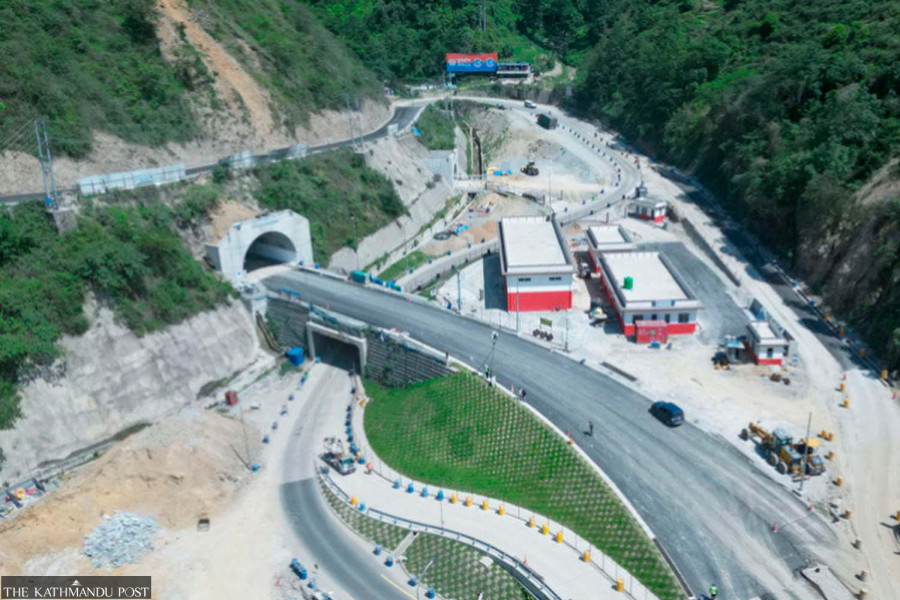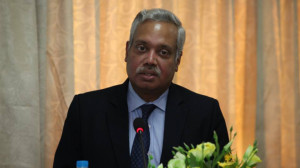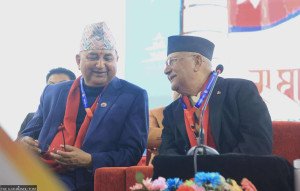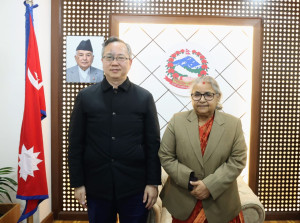National
Nagdhunga–Sisnekhola tunnel to open from January 2026, authorities say
Final testing underway as authorities prepare tolls and safety measures; journey that once took over half an hour to take just seven minutes.
Bimal Khatiwada
The Nagdhunga–Sisnekhola tunnel is scheduled to open in January 2026. Construction has reached its final stage, with only slope reinforcement near the Sisnekhola entrance remaining, said Saujanya Nepal, the tunnel project chief.
The Department of Transport Management has already issued the guidelines for tunnel operation. “Preparations are in place to open the tunnel from the English New Year. Before that, we will test all installed equipment and drive vehicles inside to check the infrastructure,” Nepal said. He said that the manpower and the authority responsible for operating the tunnel will be selected in advance, with bids to be invited within 15 days.
Final testing of installed jet fans, CCTV cameras, and lighting is ongoing. “Earlier, testing was conducted in parts. Now, everything is being tested together,” Nepal said. Landslide prevention work towards Dhading, halted during the monsoon, will resume from mid-September. Work on the Kisipidi flyover on the Kathmandu side is complete, and road marking is underway.
Toll fees for vehicles using the tunnel approved
The Cabinet has approved toll fees for vehicles using the tunnel, based on a proposal from the Nepal Road Board. The fees were sanctioned during the Cabinet meeting on August 11 and are fixed for the first two years. Cars and vans will pay Rs65 entering Kathmandu and Rs 60 exiting, with daily estimates of 859 vehicles entering and 646 exiting. Mini buses, trucks, and tippers will pay Rs115 entering and Rs80 exiting, with daily estimates of 540 vehicles entering and 406 exiting. Buses and trucks will pay Rs260 entering and Rs200 exiting, with an estimated 794 vehicles entering and 597 exiting daily. Heavy trucks will pay Rs 600 entering and Rs 250 exiting, with 596 vehicles entering and 448 exiting daily.
Ganesh Bahadur KC, executive director of the Roads Board Nepal, said the fees were finalised after discussions with relevant authorities. The tolls will only be implemented once the tunnel becomes operational.
The tunnel operation guidelines, were issued on April 7. According to the guidelines, pedestrians, two- and three-wheelers, and non-motorised vehicles will not be allowed inside the tunnel. Vehicles carrying highly flammable fuels, explosives, or other hazardous materials are prohibited. Vehicles over 18 metres or wider than 2.5 metres cannot use the tunnel. Overloaded vehicles exceeding capacity limits set by the cargo transport regulations and Department of Transport Management guidelines are also banned.
Project progress and timeline
Construction of the tunnel began on October 21, 2019, with an initial completion target of 42 months. Despite delays caused by Covid-19 and protests by locals, 94.5 percent of the work has been completed.
The project estimates that travel from Sisnekhola to Balambhu via Nagadhunga road currently takes 33 minutes to enter and 23 minutes to exit. Once the tunnel is operational, the same journey will take just seven minutes. The road from Kisipidi, Balambhu, to the tunnel entrance at Tutipakha, spanning 2.307 km, has been constructed as a two-lane road.
The main tunnel is 2,688 metres long, with an emergency tunnel of 2,557 metres. The total project cost is Rs22 billion, including a Rs16 billion concessional loan from Japan and Rs6 billion from the Nepal government. The construction contract was awarded to Japanese company Hazama Ando Corporation.
Authorities expect that the tunnel will significantly reduce traffic congestion on the Nagadhunga ascent once operational, easing commuters’ daily travel.




 17.12°C Kathmandu
17.12°C Kathmandu














